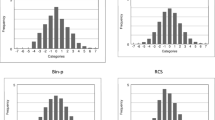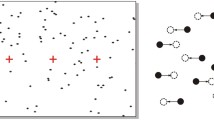Summary
Following Needleman et al.'s (1979) report of a correlation between tooth lead estimates in children and reaction time as measured by Rodnick and Shakow's (1940) delayed reaction time paradigm, a version of the procedure with two delay periods of 3 s and 12 s was developed for automated presentation and scoring on a VIC-20 microcomputer. Data are presented from a study of 300 children aged 6–14 years. Mean reaction time over six trials for each delay period related in a curvilinear fashion with age, but no relationships were found with sex or intelligence. Age-adjusted reaction time related significantly with blood-lead levels, but accounted for only about 1 per cent of the variance. The effect was mainly observed in younger (6–10 years) children in whom higher lead was associated with slower reaction time.
Similar content being viewed by others
References
Anderson R, Halcomb C, Doyle R (1973) The measurement of attention deficits. Except Child 39:534–539
Baloh R, Sturm R, Green B, Gleiser G (1975) Neuropsychological effects of chronic asymptomatic increased lead absorption. Arch Neurol 32:326–330
Czudner G, Rourke BD (1970) Simple reaction time in ‘Brain-damaged’ and normal children under regular and irregular preparatory interval conditions. Perceptual Motor Skills 31:767–773
Hindmarch I (1980) Psychomotor function and psychoactive drugs. Br J Clin Pharmacol 10:189–209
Klebelsberg D (1960) Wiener Determinationsgerät Diagnostica, IV
Landrigan PJ, Whitworth R, Baloh H, Staehling MW, Barthel WF, Rosenblum BF (1975) Neuropsychological dysfunction in children with chronic low-level lead absorption. Lancet 1:708–712
Lansdown R, Yule W, Urbanowicz M, Millar IB (1983) Blood lead, intelligence, attainment and behaviour in school children: Overview of a pilot study. In: Rutter M, Jones RR (eds) Lead versus health: Sources and effects of low level lead exposure. Wiley, Chichester
Neale MD (1958) Neale analysis of reading ability manual. MacMillan, London
Needleman H, Gunnoe C, Leviton A, Reed R, Peresie H, Maher C, Barrett P (1979) Deficits in psychological and classroom performance of children with elevated dentine lead level. N Engl J Med 300:689–695
Nie N, Hull CH (1983) S.P.S.S. users' guide. McGraw-Hill, Chicago
Rodnick EH, Shakow D (1940) Set in the schizophrenic as measured by a composite reactiontime index. Am J Psychiat 97:214–225
Taylor E (1980) Development of attention. In: Rutter M (ed) Scientific foundations of developmental psychiatry. Heinemann, London
Vernon PE (1977) Vernon graded word spelling test. Hodder and Stoughton, London
Vernon PE, Miller KM (1976) Vernon graded arithmetic-mathematics test. Hodder and Stoughton, London
Wechsler D (1974) Manual of the Wechsler intelligence scale for children-revised. Psychological Corporation, New York
Winneke G, Hrdina KG, Brockhaus A (1982) Neuropsychological studies in children with elevated tooth lead concentrations. I. Pilot study. Int Arch Occup Environ Health 51:169–183
Winneke G, Kramer U, Brockhaus A, Ewers U, Kujanek G, Lechner H, Janke W (1983) Neuropsychological studies in children with elevated tooth lead concentrations. II. Extended. Int Arch Occup Environ Health 51:231–252
Yule W, Lansdown R, Millar IB, Urbanowicz M-A (1981) The relationship between blood lead concentrations, intelligence and attainment in a school population: A pilot study. Dev Med Child Neurol 23:567–576
Yule W, Rutter M (1985) Effect of lead on children's behaviour and cognitive performance: A critical review, chapter 7. In: Mahaffey KR (ed) Dietary and environmental lead: Human health effects. Elsevier, Amsterdam
Yule W, Urbanowicz M, Lansdown R, Millar IB (1984) Teachers' ratings of children's behaviour in relation to blood lead levels. Br J Dev Psychol 2:295–305
Zahn TP, Rosenthal D, Shakow D (1961) Reaction time in schizophrenic and normal subjects in relation to the sequence of series of regular preparatory intervals. J Abnormal Soc Psychol 63:161–168
Author information
Authors and Affiliations
Additional information
This study was supported by the Medical Research Council (UK)
Rights and permissions
About this article
Cite this article
Hunters, J., Urbanowicz, M.A., Yule, W. et al. Automated testing of reaction time and its association with lead in children. Int. Arch Occup Environ Heath 57, 27–34 (1985). https://doi.org/10.1007/BF00383543
Received:
Accepted:
Issue Date:
DOI: https://doi.org/10.1007/BF00383543




